Although many would consider a meticulously assembled, beautifully presented dish a piece of art, a chef in Japan is taking the connection between art and gastronomy to the next level. Meet Natsuko Shoji, winner of the Asia’s Best Pastry Chef Award 2020, sponsored by Valrhona
When she arrived at the screening of the Asia’s 50 Best Restaurants 2020 virtual announcement in Tokyo, Natsuko Shoji sported cobalt-blue flared trousers, teamed with a stunning couture belted blazer. Fashion isn’t just one of the young chef’s passions – it is a key source of inspiration and a factor that played an important part in her journey to being crowned Asia’s Best Pastry Chef 2020.
“I look at fashion icons and trends and I try to express their aesthetics using Japanese fruit,” she says. “I want to translate what I love about the world of haute couture to cakes.”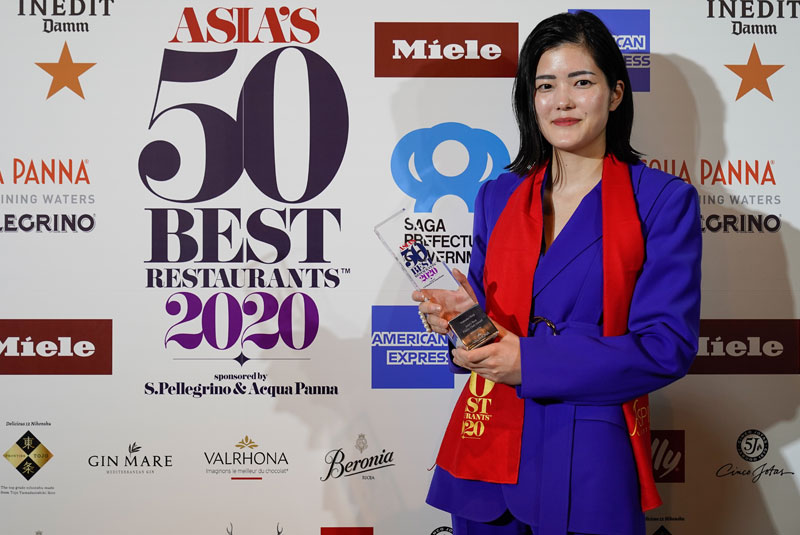
Shoji with her trophy at the screening event in Tokyo
Shoji is the owner of Été, an exclusive one-table, six-seat restaurant in Shibuya, in the heart of Tokyo. Here, as well as wowing diners with her intricate, French-inspired menus – each dish featuring only three or four ingredients – she has also built a cake lab where she crafts delicate, high fashion-inspired sweet creations that have already sold to customers as famous as David Beckham and René Redzepi.
The Japanese chef inherited her love of fashion from her mother; the passion for cooking was developed in her teens. “When I was in junior high school, my favourite subject was home economics. An assignment to make cream puffs got me interested in baking, as I felt extremely thrilled seeing the pastries rise in the oven. After this, I made cream puffs for my friends. It was such a wonderful way to make something for the people who are important to me,” she recalls.
Shortly after graduating high school, Shoji managed to get a job at Florilège, Hiroyasu Kawate’s renowned restaurant that was voted No.7 in Asia’s 50 Best Restaurants 2020. The chef regards Kawate as the biggest influence on her style – she says he taught her that “guests deserve the most perfect experience, every single time”. Under him, she quickly rose through the ranks to the position of sous chef, but in 2014 aged just 23, she felt it was time to follow her dream.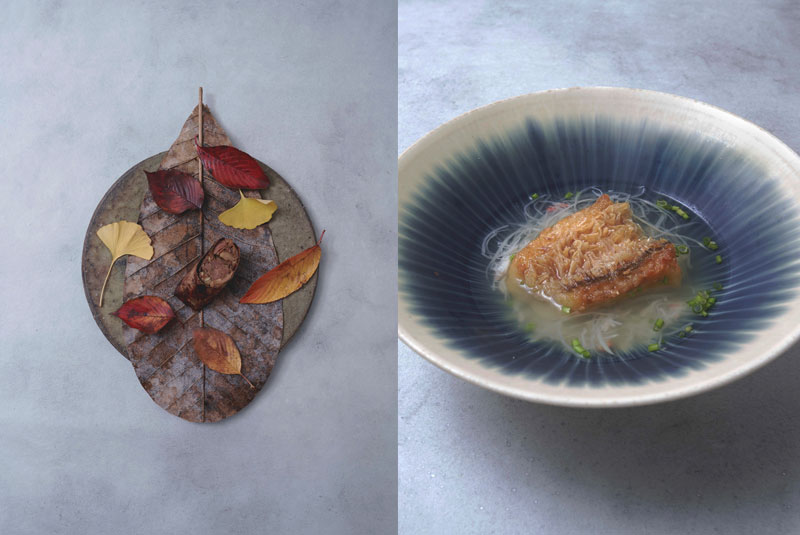
Shoji's savoury creations: Chimaki Top and Amadai
“My mother was very worried when I opened Été because I had to take out a loan from the bank,” she says. “I had to work hard to support my family and my younger sister, who suffers from health problems. My father passed away when I was 21. I needed to be strong and successful.”
Strong and successful women are not what the Japanese restaurant industry is known for, but the chef is determined to drive change in this area. “There are not enough female chefs in Japan. I want everyone to have equal chances,” she says. “To all the female chefs out there, know that you can start small and stay small. There is no need to open a big restaurant with big money. Your success is not measured by how big and famous you are, but by the happiness of your customers and the smiles on their faces. The rest will fall into place.”
Shoji’s bet paid off. Within five years of opening her restaurant and cake business, she is now regarded as one of the most accomplished pastry chefs in all of Asia, with customers – famous and otherwise – making trips around the globe to taste her creations or buy one of her cakes, some of which can cost up to $2,000.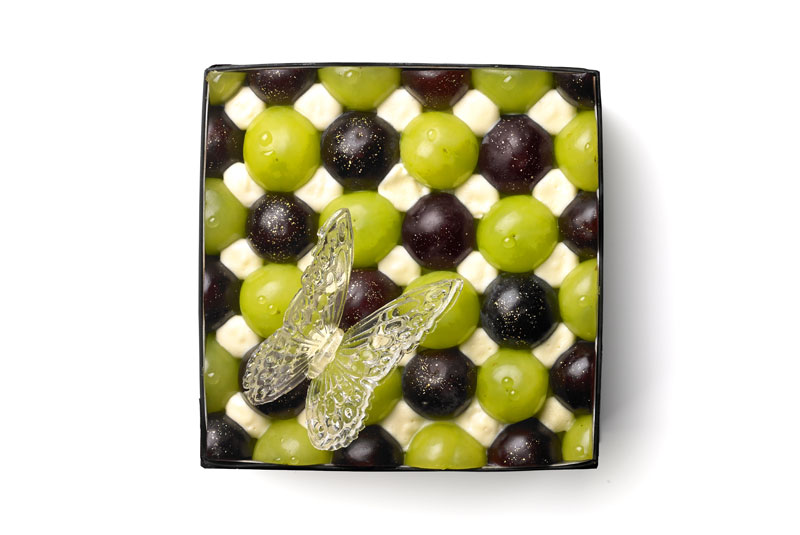
Bouton cake
With her unique concept, Shoji has carved herself a special space within Tokyo’s ever-growing and competitive dining scene. But the winning combination of her passions for gastronomy and fashion was missing a final piece: she completed the puzzle with her interest in high-quality, seasonal and rare Japanese fruit. “I work only with the best products to make sure I can achieve the best results,” she says. “I also hand-pick each fruit to make sure it is to my standard. It really pays off.”
These three elements work together like complementary parts of a well-oiled machine, and the best way to understand the relationship among them is by hearing the chef describe one of her cakes. “My peach cake, which uses two kinds of Japanese peaches and a custard filling, is inspired by my mother’s love for Chanel,” she explains. “I took inspiration from Chanel’s Matelassé bags and their diamond-shaped stitching, cutting the peaches and arranging them in a similar design.
“My Bouton [French for button] cake alternates Shine Muskat and purple Nagano grape varieties with spoonfuls of lime-flavoured mascarpone cream, arranged to look like the Comme des Garçons’ dot pattern. The Damier cake [French for checkerboard] replicates the Louis Vuitton Damier print using Akahoppe red and Awayuki white strawberries atop a layer of sponge.”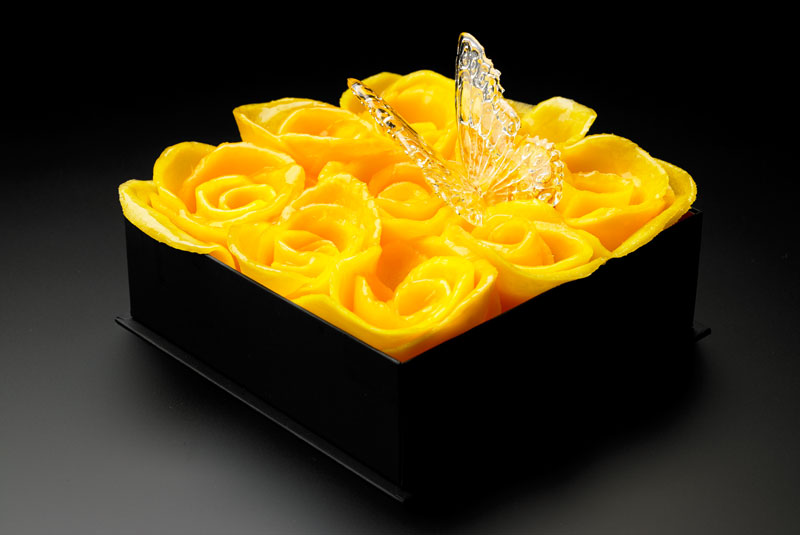
Mango cake
However, the chef’s signature cake is the one she created from her favourite fruit: mango. “It was the first cake I ever created, made with a sablé cookie base, custard and petals of mango shaped to look like rose,” she says. The elegant, eye-catching creation marked her arrival as a top-level exponent of patisserie, and the gastronomic community in Asia soon took notice, voting her as the winner of the Asia’s Best Pastry Chef Award 2020, sponsored by Valrhona.
“It was like a dream come true,” says Shoji. “I feel very honoured. There is still a very limited number of female chefs in Japan, therefore for a small restaurant like mine to win an award, I feel that it will connect me to a brighter future. For that, I am very grateful.”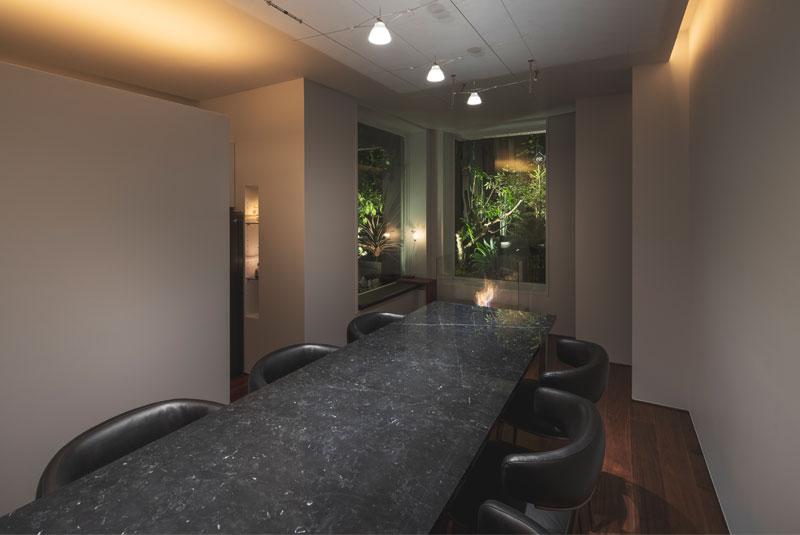
Été's six-seat dining room
With Prime Minister Shinzo Abe declaring a state of emergency in Japan in response to the coronavirus pandemic on 7th April, there is fear in the restaurant industry that closures may be around the corner, especially in hard-hit Tokyo. Shoji highlights that many overseas customers have been cancelling their reservations at Été.
“There is no guarantee for the F&B industry from the government,” she comments. “We still need to work to pay rent, other costs and to support our staff and their families. No matter how dangerous it is during such crisis, we, as chefs, still must prepare food from the early morning, commute and go through our everyday routine.”
But this isn’t the first challenge that Shoji faces head on. After all, her restaurant Été – meaning summer in French – was inspired by her own name, which can be translated “summer child”. The young chef has a bright future ahead and looks forward to the day when the sun will shine again.
Now watch the video to see Shoji at work:
Browse the full list of Asia’s 50 Best Restaurants 2020 on the website and discover all the individual awards recognising the work of chefs and restaurants in the region. Follow 50 Best on Instagram, Facebook, Twitter and YouTube for the latest news and initiatives in support of the global restaurant industry.

